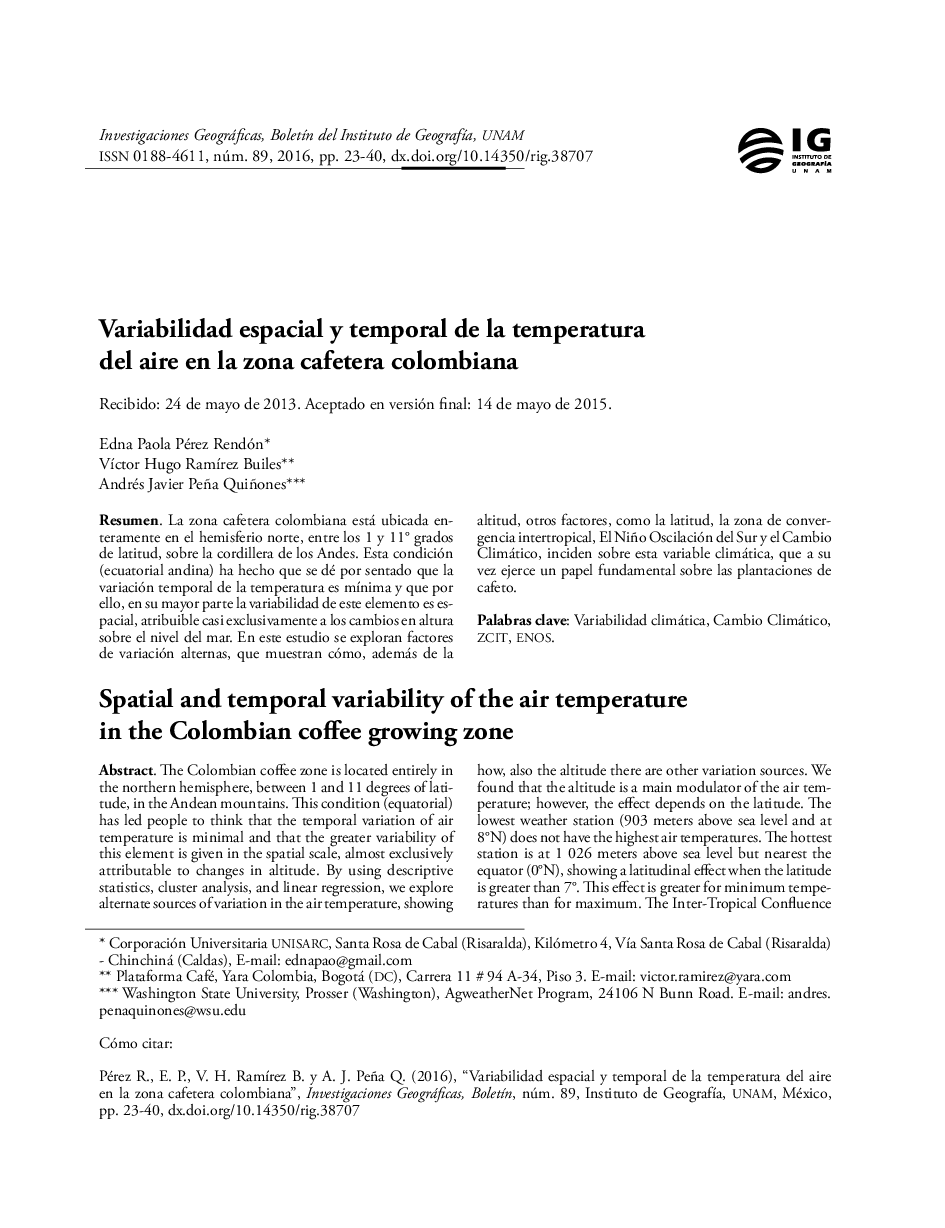| کد مقاله | کد نشریه | سال انتشار | مقاله انگلیسی | نسخه تمام متن |
|---|---|---|---|---|
| 7474506 | 1485179 | 2016 | 18 صفحه PDF | دانلود رایگان |
عنوان انگلیسی مقاله ISI
Variabilidad espacial y temporal de la temperatura del aire en la zona cafetera colombiana
ترجمه فارسی عنوان
تغییرات فضایی و زمانی دما در هوا در منطقه قهوه کلمبیا
دانلود مقاله + سفارش ترجمه
دانلود مقاله ISI انگلیسی
رایگان برای ایرانیان
کلمات کلیدی
موضوعات مرتبط
علوم انسانی و اجتماعی
علوم اجتماعی
جغرافیا، برنامه ریزی و توسعه
چکیده انگلیسی
The Colombian coffee zone is located entirely in the northern hemisphere, between 1 and 11 degrees of latitude, in the Andean mountains. This condition (equatorial) has led people to think that the temporal variation of air temperature is minimal and that the greater variability of this element is given in the spatial scale, almost exclusively attributable to changes in altitude. By using descriptive statistics, cluster analysis, and linear regression, we explore alternate sources of variation in the air temperature, showing how, also the altitude there are other variation sources. We found that the altitude is a main modulator of the air temperature; however, the effect depends on the latitude. The lowest weather station (903 meters above sea level and at 8°N) does not have the highest air temperatures. The hottest station is at 1 026 meters above sea level but nearest the equator (0°N), showing a latitudinal effect when the latitude is greater than 7°. This effect is greater for minimum temperatures than for maximum. The Inter-Tropical Confluence Zone (ITCZ) can modulate the air temperature. In most of the stations located between 2 and 7°N, the air temperature gets maximum values when the ITZC is in its extreme North and South positions. It means, between December and January and between July and September, maximum temperatures tend to be higher than in any other month. Minimum temperatures are not affected by ITCZ as much as maximum temperatures are, indicating that this variable is impacted by the day-night cycle more than for the ITCZ. El Niño Southern Oscillation affects the air temperature in the coffee zone. During “El Niño“, the air temperature increases, while it decreases during “La Niña“ events. However, there is a higher relation between maximum air temperatures and ENSO than between this phenomenon and the minimum air temperatures. The effect of this phenomenon on the air temperature is higher during the first semester of the year, specifically between January and March. On the other hand, there is evidence to think that the air temperature is changing in the analyzed stations. For example, 47% of the analyzed stations exhibit changes (trends) in maximum air temperature values. Most of the trends are positive (air temperature increasing), but there are some places where the values have been decreasing. However, 84% of the analyzed minimum air temperature series have significative trends. Most of the locations have been seeing increasing air temperature values over the last decades.
ناشر
Database: Elsevier - ScienceDirect (ساینس دایرکت)
Journal: Investigaciones Geográficas, BoletÃn del Instituto de GeografÃa - Volume 2016, Issue 89, April 2016, Pages 23-40
Journal: Investigaciones Geográficas, BoletÃn del Instituto de GeografÃa - Volume 2016, Issue 89, April 2016, Pages 23-40
نویسندگان
Edna Paola Pérez Rendón, VÃctor Hugo RamÃrez Builes, Andrés Javier Peña Quiñones,
